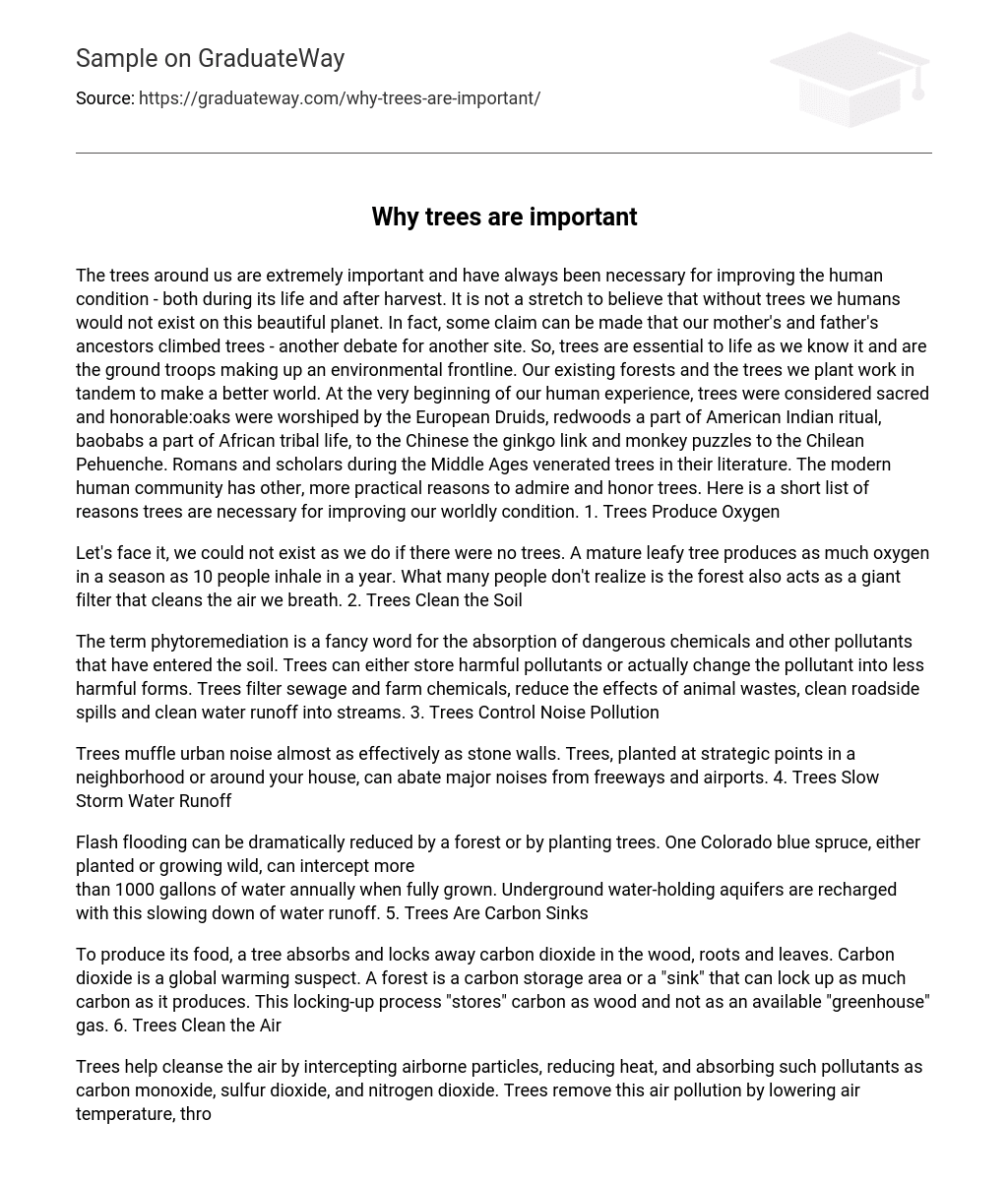The trees around us are extremely important and have always been necessary for improving the human condition – both during its life and after harvest. It is not a stretch to believe that without trees we humans would not exist on this beautiful planet. In fact, some claim can be made that our mother’s and father’s ancestors climbed trees – another debate for another site. So, trees are essential to life as we know it and are the ground troops making up an environmental frontline. Our existing forests and the trees we plant work in tandem to make a better world. At the very beginning of our human experience, trees were considered sacred and honorable:oaks were worshiped by the European Druids, redwoods a part of American Indian ritual, baobabs a part of African tribal life, to the Chinese the ginkgo link and monkey puzzles to the Chilean Pehuenche. Romans and scholars during the Middle Ages venerated trees in their literature. The modern human community has other, more practical reasons to admire and honor trees. Here is a short list of reasons trees are necessary for improving our worldly condition. 1. Trees Produce Oxygen
Let’s face it, we could not exist as we do if there were no trees. A mature leafy tree produces as much oxygen in a season as 10 people inhale in a year. What many people don’t realize is the forest also acts as a giant filter that cleans the air we breath. 2. Trees Clean the Soil
The term phytoremediation is a fancy word for the absorption of dangerous chemicals and other pollutants that have entered the soil. Trees can either store harmful pollutants or actually change the pollutant into less harmful forms. Trees filter sewage and farm chemicals, reduce the effects of animal wastes, clean roadside spills and clean water runoff into streams. 3. Trees Control Noise Pollution
Trees muffle urban noise almost as effectively as stone walls. Trees, planted at strategic points in a neighborhood or around your house, can abate major noises from freeways and airports. 4. Trees Slow Storm Water Runoff
Flash flooding can be dramatically reduced by a forest or by planting trees. One Colorado blue spruce, either planted or growing wild, can intercept more
than 1000 gallons of water annually when fully grown. Underground water-holding aquifers are recharged with this slowing down of water runoff. 5. Trees Are Carbon Sinks
To produce its food, a tree absorbs and locks away carbon dioxide in the wood, roots and leaves. Carbon dioxide is a global warming suspect. A forest is a carbon storage area or a “sink” that can lock up as much carbon as it produces. This locking-up process “stores” carbon as wood and not as an available “greenhouse” gas. 6. Trees Clean the Air
Trees help cleanse the air by intercepting airborne particles, reducing heat, and absorbing such pollutants as carbon monoxide, sulfur dioxide, and nitrogen dioxide. Trees remove this air pollution by lowering air temperature, through respiration, and by retaining particulates. 7. Trees Shade and Cool
Shade resulting in cooling is what a tree is best known for. Shade from trees reduces the need for air conditioning in summer. In winter, trees break the force of winter winds, lowering heating costs. Studies have shown that parts of cities without cooling shade from trees can literally be “heat islands” with temperatures as much as 12 degrees Fahrenheit higher than surrounding areas. 8. Trees Act as Windbreaks
During windy and cold seasons, trees located on the windward side act as windbreaks. A windbreak can lower home heating bills up to 30% and have a significant effect on reducing snow drifts. A reduction in wind can also reduce the drying effect on soil and vegetation behind the windbreak and help keep precious topsoil in place. 9. Trees Fight Soil Erosion
Erosion control has always started with tree and grass planting projects. Tree roots bind the soil and their leaves break the force of wind and rain on soil. Trees fight soil erosion, conserve rainwater and reduce water runoff and sediment deposit after storms. 10. Trees Increase Property Values
Real estate values increase when trees beautify a property or neighborhood.
Trees can increase the property value of your home by 15% or more.





